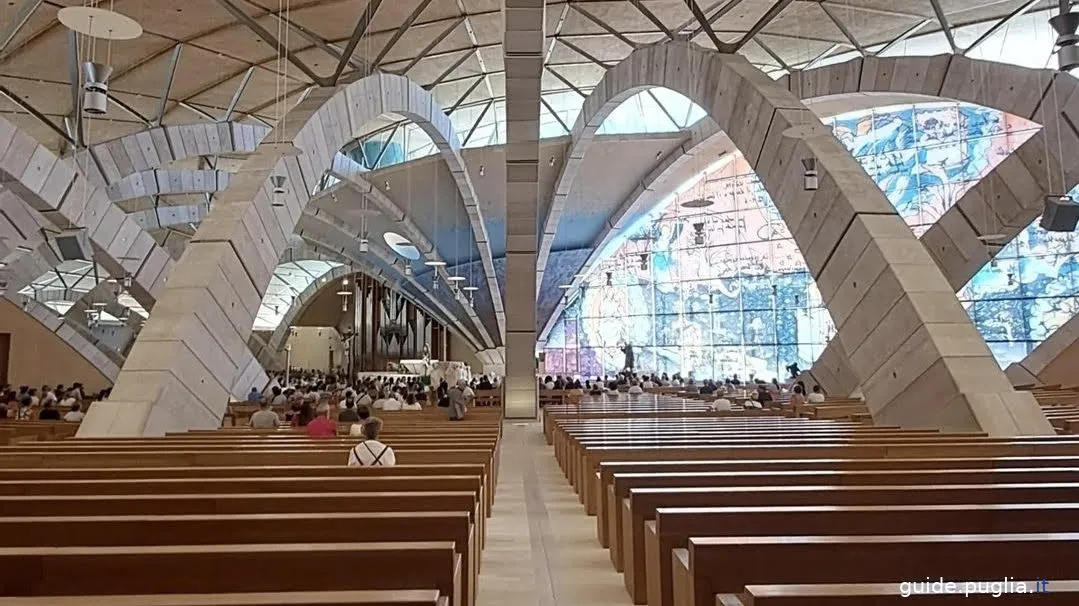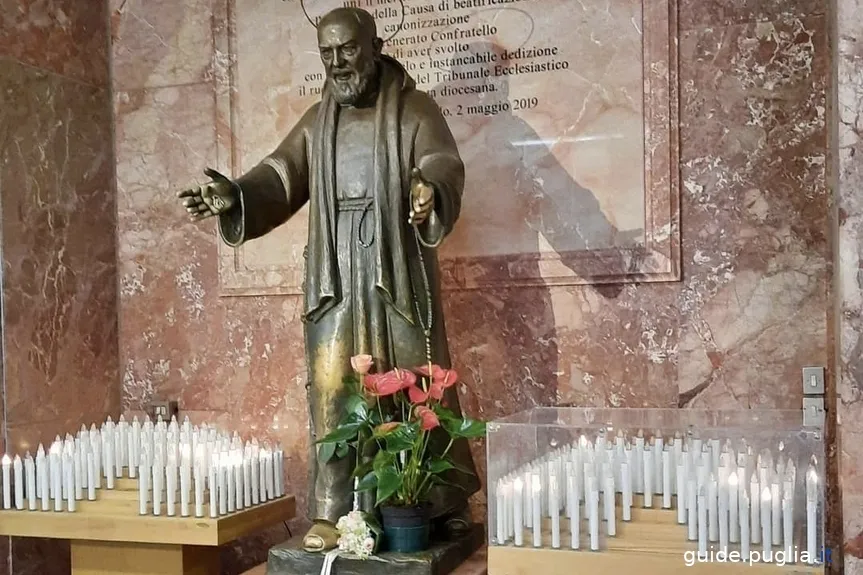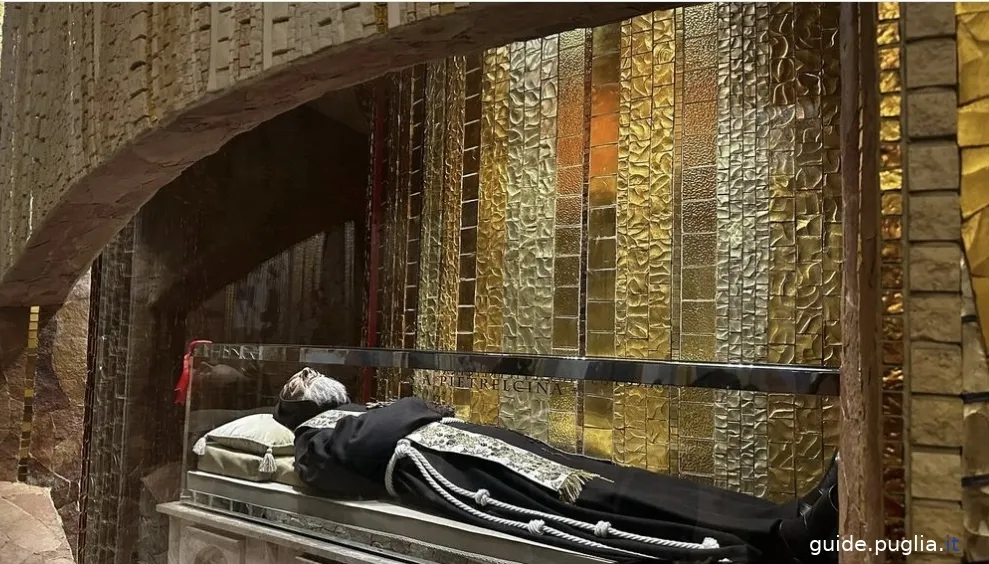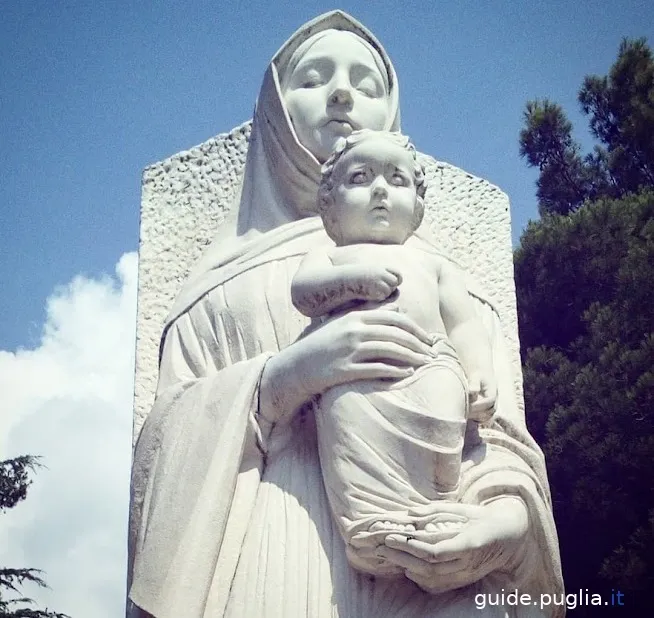San Giovanni Rotondo: Pilgrimage Sites and Spiritual Traditions in the Land of Padre Pio.
Updated at: 01-12-2024
How this content can help you:
- The connection between San Giovanni Rotondo and Padre Pio.
- How to reach San Giovanni Rotondo.
- Where to park in the city.
- The main points of interest, including the Sanctuary and the Padre Pio Museum.
- Details about the Sanctuary of San Pio.
- The annual events and celebrations dedicated to Padre Pio.

San Giovanni Rotondo is a town located in the Puglia region of southern Italy. It is part of the Gargano National Park and is especially renowned for its connection to Saint Pio of Pietrelcina, also known as Padre Pio.
Padre Pio, a Capuchin friar known for his alleged miracles and stigmata, spent much of his life in San Giovanni Rotondo, where he played a crucial role in the religious life of the community. His works and example continue to inspire and attract pilgrims from all over the world.
How to Reach San Giovanni Rotondo
By Car:
- From Naples: About 2 hours by car, following the A16 Motorway to the Candela exit, then continue on SS655 to San Giovanni Rotondo.
- From Bari: About 1.5 hours by car, traveling on the A14 Motorway and then following SS272 to San Giovanni Rotondo.
- From Rome: About 3 hours by car, following the A24 and A14 Motorways, then take SS272.
By Train:
The nearest train station is in Foggia. From Foggia, you can take a direct bus to San Giovanni Rotondo, which takes about 1.5 hours.
By Bus:
Several bus companies offer connections from major cities such as Rome, Naples, Bari, and Foggia to San Giovanni Rotondo. Check local bus company schedules and availability to plan your trip.
By Air:
The nearest airport is Bari-Palese Airport (Bari Karol Wojtyła), about 1.5 hours by car from San Giovanni Rotondo. From there, you can rent a car or take a bus to reach the town.
Where to Park
- San Pio Sanctuary Parking: There is a large paid parking area near the Sanctuary of San Pio, which is well-signposted and offers spaces for visitors. As this is a highly frequented destination, especially during pilgrimage periods, it's advisable to arrive early to find a spot.
- Public Parking: There are several public parking areas near the center of San Giovanni Rotondo, some of which are paid. Look for areas marked with blue lines, indicating paid parking.
- Reserved Spaces: The Sanctuary and other public areas have reserved parking spaces for disabled individuals.
- Group Parking: If traveling with an organized group, there are designated bus parking areas, often located near major points of interest like the Sanctuary.
Points of Interest in San Giovanni Rotondo
San Giovanni Rotondo offers numerous places of interest that attract pilgrims and visitors from around the world. These sites not only recount the life and legacy of Padre Pio but also offer a unique spiritual and cultural experience for all who visit.
Among these:
- Sanctuary of Saint Pio of Pietrelcina, which includes both the New Church and the Old Church.
- Casa Sollievo della Sofferenza
- Museum of Padre Pio
- Capuchin Friars' Convent
- Monumental Via Crucis
Sanctuary of Saint Pio of Pietrelcina

The Sanctuary of Saint Pio of Pietrelcina is situated on a hill overlooking the town, offering a panoramic view and a position that emphasizes its spiritual importance. The Sanctuary continues to attract millions of visitors and pilgrims each year, providing a unique experience of devotion and spirituality that honors Padre Pio's legacy and helps keep his memory alive.
The Sanctuary consists of two main churches:
New Church:
Designed by architect Renzo Piano, this modern and luminous church was inaugurated in 2004. The structure, characterized by elegant lines and a spacious interior, houses Padre Pio's tomb, allowing pilgrims to pay their respects to the saint.
The interior of the church features a dedicated prayer area, with a design that fosters reflection and spirituality.

Old Church:
This smaller, historic church was the place where Padre Pio celebrated Mass and welcomed the faithful during his lifetime.
The Old Church retains the spiritual atmosphere and original appearance of the era when Padre Pio was active, offering a direct connection to the history and spirituality of the saint.
Access and Regulations:
- Opening Hours: Both churches are generally open daily. Hours may vary depending on religious celebrations and special events. It is advisable to check current hours before visiting.
- Access: Access to the Sanctuary is free. However, during high-attendance religious celebrations or special events, restrictions may apply, or guided tours may be organized.
- Visits and Celebrations: You can participate in Masses, confessions, and other religious celebrations. Guided tours can be booked in advance for groups or individual visitors.
- Admission Costs: Entry to the Sanctuary is free. However, contributions are encouraged to support the maintenance and activities of the Sanctuary. During special events, small fees may be requested for participation in special services or guided tours.
Casa Sollievo della Sofferenza
Founded in 1956 by Padre Pio da Pietrelcina, Casa Sollievo della Sofferenza is a high-specialization hospital located in San Giovanni Rotondo.
Padre Pio, known for his deep commitment to the sick and needy, aimed to create an institution that provided quality medical care to those who could not afford it and addressed the healthcare needs of the region.
Casa Sollievo della Sofferenza is a modern hospital offering a wide range of specialized medical services. It is equipped with the latest diagnostic and therapeutic technologies and has departments of excellence in various medical specialties.
The hospital provides care in many areas, including cardiology, oncology, neurosurgery, orthopedics, and internal medicine. It has emergency departments, intensive care units, analysis laboratories, and imaging diagnostics services.
Casa Sollievo della Sofferenza is also a center for research and training, collaborating with universities and research institutes to promote clinical studies and innovations in medicine.
The hospital is a tangible testament to Padre Pio's commitment to alleviating suffering and improving the quality of life for the sick. Its foundation reflects the saint's dedication to caring for the needy and his desire to offer high-quality healthcare.
Casa Sollievo della Sofferenza remains a lasting legacy of Padre Pio's work, representing a beacon of hope and care for many and continuing to follow the saint's mission of alleviating suffering and providing high-quality assistance to those in need.
Access and Visits:
- Guided Tours: Some areas of the hospital can be visited by request. The hospital also offers tours for pilgrim groups and visitors interested in learning about the history and impact of the institution.
- Donations and Support: Casa Sollievo della Sofferenza accepts donations and contributions to support its activities and ensure the quality of the services provided.
Museum of Padre Pio
The Museum of Padre Pio was founded with the aim of preserving and disseminating the legacy of Padre Pio of Pietrelcina. Inaugurated in 1999 through the initiative of the Capuchin Friars and the support of donations from faithful and supporters, the museum has made possible the collection, cataloging, and public access to a wide range of historical and religious materials related to the life and work of the saint.
The museum plays a crucial role in preserving the memory of Padre Pio, ensuring that his legacy remains alive and relevant for future generations. Through the presentation of documents and historical objects, the museum provides a context for visitors to understand and reflect on the historical and spiritual role of Padre Pio, while also offering inspiration and insight.
As a key reference point for pilgrims visiting San Giovanni Rotondo to honor Padre Pio, the museum often integrates into the pilgrimage route, which also includes participation in religious celebrations and visits to the Sanctuary and other significant sites.
Additionally, the museum actively collaborates with research institutes, universities, and other organizations to promote studies and research on Padre Pio’s life and works. These collaborations continuously enrich the content and exhibitions, helping to expand and deepen the understanding of the saint's figure.
Collections and Exhibitions of the Museum of Padre Pio:
Personal Items:
In the Museum of Padre Pio, one of the main focuses is on personal items that offer an intimate glimpse into the saint’s life and ministry.
Among the most significant pieces are religious garments: the habits and tunics worn by Padre Pio during religious ceremonies and his daily work. These garments are not only historical artifacts but also tangible testimonies of his spiritual commitment and ministry, allowing visitors to connect closely with his life experience.
The museum also houses numerous rosaries and crucifixes, objects that Padre Pio used in his spiritual practice. These items hold special meaning for pilgrims, reflecting Padre Pio's deep connection with prayer and meditation. Their display provides a direct link to the saint's spirituality.
Moreover, various work tools used by Padre Pio in his daily life are exhibited. These include his desk and the pen with which he wrote letters and notes. These items provide a more detailed view of his daily activities and practices, enriching the understanding of his life and work.
Photographs and Documents:
The Museum of Padre Pio offers a rich selection of photo albums capturing different aspects of the saint’s life. These photographs range from intimate and family moments to public events and religious celebrations, providing a comprehensive and engaging snapshot of his existence and ministry.
Another valuable section of the museum is represented by letters and personal writings of Padre Pio. These documents, addressed to family, friends, and devotees, are of immense historical and spiritual value.
Through his words, visitors can explore his inner world, relationships, and thoughts, offering a profound connection with his life and faith.
Additionally, the museum preserves Padre Pio’s diaries and personal notes. These writings offer a detailed overview of his daily experiences and spiritual reflections, further enriching the understanding of his inner life and path to sainthood.
Through these documents, visitors can uncover the thoughts and emotions that guided the saint in his journey.
Relics
The Museum of Padre Pio also hosts a selection of significant relics, including ashes and body parts, as well as garments and gloves worn by Padre Pio. These items are preserved with the utmost respect and displayed in special cases.
This arrangement allows visitors to reflect on their spiritual significance, providing a moment of contemplation and deep connection with the saint’s figure.
Furthermore, the museum features miraculous objects associated with the miracles attributed to Padre Pio. Among these are blessed items and objects believed to have been healed through the saint’s intercession.
These items not only testify to Padre Pio's fame as a miracle worker but also allow visitors to explore and appreciate his spiritual impact and the profound bond he had with his devotees.
Thematic Exhibitions:
The Museum of Padre Pio hosts a variety of temporary exhibitions celebrating significant events in the saint’s life. These exhibitions may commemorate important anniversaries, such as the centenary of his birth, and include special documents and objects that are not normally on display.
These events provide a unique opportunity for visitors to explore particular aspects of Padre Pio’s life and reflect on crucial moments of his existence.
Some exhibitions focus on different phases of Padre Pio's life, providing an in-depth overview of his formative years, his ministry in San Giovanni Rotondo, and the period of his fame and canonization.
Each exhibition is designed to offer a detailed understanding of these key moments, illustrating the evolution of his life and his lasting impact.
The museum also dedicates space to the most recent research and innovations related to Padre Pio. Exhibitions include updates on new discoveries and studies regarding his visions, miracles, and the influence of his sainthood on contemporary life. These insights help visitors stay informed about the latest developments and further appreciate Padre Pio’s spiritual legacy.
Useful Information:
- Parking: The museum has dedicated parking for visitors. There are also public parking areas and paid zones nearby.
- Accessibility for Disabled Individuals: The Museum of Padre Pio is accessible to people with disabilities. Exhibition spaces are designed to accommodate all visitors, with ramps and elevators ensuring access for those with reduced mobility.
- Opening Hours: The museum is open daily, but hours may vary depending on the season and special events.
- Guided Tours: Guided tours of the Museum of Padre Pio offer detailed insights into the saint’s life and the museum’s exhibitions. Available for groups and individuals, these tours are conducted by experts and can be booked in advance, often in various languages. Each tour lasts between 60 and 90 minutes and includes in-depth explanations of the exhibited items, with the opportunity to interact and ask questions.
Convento dei Frati Cappuccini
Founded in 1731, the convent gained significant importance after Padre Pio's arrival in 1916. Here, Padre Pio spent much of his life, dedicating himself to prayer and spiritual guidance.
The convent has been a vital center for the religious community and pilgrims. It still preserves some of the rooms and spaces used by Padre Pio, offering a direct connection to his life and ministry.
Guided Tour
During a visit to the Convento dei Frati Cappuccini, visitors can expect a profound and meaningful experience exploring Padre Pio's life and spirituality.
The tour begins with a visit to Padre Pio's personal rooms, where you can admire the furniture and objects that the saint used daily. These spaces provide an intimate glimpse into his life and spiritual commitment.
The prayer cell of Padre Pio is a crucial part of the tour. This space, where the saint spent long hours in meditation, allows visitors to better understand his deep relationship with prayer and spirituality.
Another significant stop on the tour is the convent's chapel, a sacred place where liturgical celebrations and daily prayers were held. The chapel maintains an atmosphere of peace and reflection, offering visitors a moment of calm and meditation.
The convent also houses a collection of historical and religious objects related to Padre Pio. These include garments, rosaries, and work tools that belonged to the saint. These artifacts provide a tangible and deep context for understanding Padre Pio’s life and daily practices.
The tour is often led by Capuchin friars or specialized guides who provide detailed explanations about the convent's history and Padre Pio's life. The guides are ready to answer questions and offer insights into various aspects of the site, enriching the visitor's experience.
The convent also includes spaces dedicated to personal reflection and prayer. These areas allow visitors to spend time in meditation and reflection, offering an opportunity to connect spiritually with Padre Pio's legacy.
During certain times of the year, it is possible to attend liturgical celebrations or special events held at the convent. These moments enrich the visitor's experience and offer a deeper connection with the religious life of the place.
Finally, the tour also provides an overview of the historical context of the convent and its role in Padre Pio's life, helping to understand how the convent became an important center of spirituality and devotion.
Entrance: Admission to the convent is usually free.
Dress Code: Wear respectful clothing in line with the religious context of the place.
Monumental Via Crucis
The Monumental Via Crucis was inaugurated in 1999 and was designed to honor the 50th anniversary of the foundation of Casa Sollievo della Sofferenza, the hospital created by Padre Pio. It is a work that reflects the importance of spirituality and personal reflection in the Christian tradition.
The work was designed by a group of artists and architects with the intention of offering an outdoor path for meditation and prayer.
It winds through a panoramic route immersed in nature, with 14 stations representing the key moments of Christ’s Passion, from the condemnation to death to the burial, offering pilgrims a tranquil and contemplative environment. Each station is represented by large bronze sculptures, created with artistic and symbolic details.

The sculptures were made by prominent artists and are designed to evoke reflection and meditation. Each station is a visual and dramatic representation of the key moments of the Via Crucis, with an artistic style that combines realism and symbolism.
During certain liturgical periods, such as Lent and Good Friday, the Via Crucis is used for special celebrations and processions.
Events and Celebrations
In San Giovanni Rotondo, annual celebrations and notable events are primarily centered around the figure of Padre Pio and the life of the religious and civil community.
Here are some of the most important events and celebrations that take place each year in the town:
Feast of San Pio da Pietrelcina (September 23)
The Feast of San Pio da Pietrelcina, celebrated on September 23, is undoubtedly the most significant event of the year in San Giovanni Rotondo. This day honors Padre Pio's life and sanctity with a series of festivities that attract pilgrims from around the world.
The celebrations begin with a solemn Mass at the New Church of the Sanctuary of San Pio, presided over by ecclesiastical authorities, followed by a grand Eucharistic procession. The faithful walk through the streets of San Giovanni Rotondo in a journey that combines spirituality and community.
The atmosphere is enriched by moments of prayer and reflection, and the entire day is animated by special events, including concerts and theatrical performances, creating a profound and memorable experience.
Anniversary of Padre Pio's Death (September 23)
September 23 is not only the feast of San Pio but also the anniversary of his death. This coincidence adds a special dimension to the celebration, with special liturgies and moments of meditation reflecting on the significance of Padre Pio’s spiritual legacy.
The faithful participate in religious services that honor the saint's memory and celebrate his lasting impact on faith and spirituality. Reflection on his life and work is a central theme of the day, enriching the sense of devotion and respect.
Novena to Padre Pio (September 14-22)
The novena preceding the Feast of San Pio, from September 14 to 22, is a period of intense prayer and meditation. Each day of the novena is marked by Eucharistic celebrations, rosaries, and moments of prayer dedicated to Padre Pio.
This nine-day period serves as spiritual preparation for the grand feast, helping the faithful to focus their hearts and minds on the celebration of September 23. The daily celebrations create an atmosphere of anticipation and reflection that enriches the entire religious experience.
Anniversary of Padre Pio's Beatification (May 2)
May 2 is the anniversary of Padre Pio's beatification, a date of great importance in the history of his sanctity. The celebration includes solemn Masses and special prayers, and is commemorated with reflections on the significance of the beatification and its impact on the saint's life and his devotees.
This day is characterized by a more intimate but profoundly significant celebration, recalling the progress in recognizing Padre Pio’s holiness and his connection with the Church.
Feast of Madonna delle Grazie (August 15)
August 15, the Feast of Madonna delle Grazie, is another important celebration in San Giovanni Rotondo. Although not directly related to Padre Pio, the Madonna delle Grazie is highly venerated in the region.
The feast includes processions, Masses, and prayers in honor of the Madonna, reflecting the city's religious tradition. The celebration is characterized by a sense of devotion and community, with events that attract both residents and pilgrims.
Feast of San Francesco d’Assisi (October 4)
October 4 marks the Feast of San Francesco d’Assisi, a significant event in the Capuchin calendar. Although Padre Pio is the central figure in San Giovanni Rotondo, the feast of San Francesco is celebrated with religious events that reflect on the life and legacy of the founder of the Capuchin Order.
The day is dedicated to reflections on Franciscan spirituality and the impact San Francesco had on the Order and the Church. Celebrations include liturgies and moments of prayer that unite the faithful in shared devotion.
Conclusion
San Giovanni Rotondo, located in the heart of Puglia, represents an important center of spirituality and devotion, known worldwide for its connection with Saint Pio of Pietrelcina.
The town, with its Sanctuary of San Pio da Pietrelcina and the Convento dei Frati Cappuccini, continues to attract pilgrims and visitors seeking reflection and prayer.
The places of worship, including the Monumental Via Crucis and Casa Sollievo della Sofferenza, offer not only a deep religious heritage but also a call to solidarity and human care.
